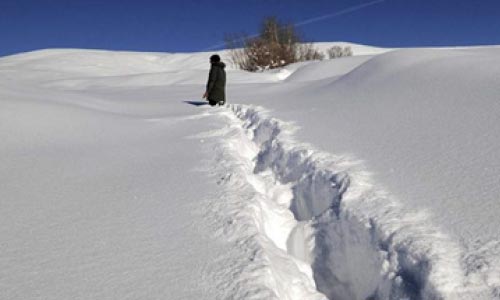Suffering successive years of drought and climate change, the current white winter has brought out some good news and also some bad news in the country. The good news are expressed by the farmer community and agriculture experts that the longstanding drought will be eliminated in the year coming due to the heavy snow fall. Recently, the government officials also has confirmed of a good and productive year ahead due to the same reason. Meanwhile, it has also created some unpleasing issues in several parts of the country. On 1 March, heavy rains struck several parts of Kandahar city including Zheri, Dand, Damand, Arghandab, Spinboldak, and Takhtapu Districts. According to statement issued by provincial governor’s office in Kandahar, at least 12 people lost their lives after heavy rain falls and flash floods hit parts of Kandahar province on Saturday. As quoted, the statement said 379 families were affected in different parts of Kandahar city and their homes were damaged by the sudden floods.
The statement added that 1,575 homes were destroyed in all districts of the province and the families were taken to safe places. At least 18 others including women and children were wounded in the incident and they are under treatment, the statement said. The statement also said that 1,200 people were rescued by the Air Force and security forces. According to officials, humanitarian organization will start distribution of food and non-food materials to all displaced people. Provincial governor Hayatullah Hayat praised security forces efforts for rescuing civilians and thanked relevant institutions for their cooperation and asked humanitarian aid organizations to provide food and non- food materials to the affected families.
Likewise, a large number of Kochi (nomadic) families, about 500 people, were stranded on the river bank and there was an urgent need for air support to rescue them. The rugged mountainous terrain, heavy snowfall and lack of roads were retarding the pace of immediate relief and rescue operations, quoted from a senior official working for the Afghanistan Natural Disaster Management Authority in Kabul. Thus, “At least 10 people, including children, are still missing,” the UN agency said. “It is anticipated that up to 2,000 homes may have been damaged.”
In addition to humanitarian losses, it has also caused some economic damages; reportedly, it has inflicted severe damages to regional infrastructure in Kandahar province including damaging some roads, houses and also public buildings. Government offices in PD#6 have been affected with buildings and documentation damaged or lost. As aforementioned, Flash floods triggered by the heavy rain have reportedly killed 12 people, including a number of children, when their homes collapsed or the vehicles they were traveling in were swept away.
The Flood-affected families have been evacuated to secure areas in the districts and Kandahar city including schools, mosques, Government buildings and the Haji camp but they are still in need of food and non-food aid item. According to the government officials about 400 families have been rescued by the Afghan army since the flooding began late Friday night. the rescue operations, however, were largely delayed due to heavy rainfall, as quoted from Raziq Shirzai, the provincial commander of the Afghan air force. Disasters such as avalanches and flash floods often hit mountainous areas and river valleys of Afghanistan as snow melts in the spring and summer. It is made worse by deforestation. Heavy snowfall across large swathes of Afghanistan this winter has raised fears of severe flooding as spring approaches, following years of devastating drought in the country. It comes after a recent flood that nearly 50 people have been killed due to flooding in other parts of Afghanistan so far this year, as quoted from the UN officials.
This year flood crisis comes after longstanding drought which had resulted shortage of grazing land and drinking water, affected almost 95% of the farmers in last summer. In 2018 it was said that Afghanistan received less than 30 % of their average annual precipitation. As a result, at least 150,000 heads of livestock had perished in that year due to the severe damage of drought in 22 provinces of the country with causing many internal movements to urban centers. According to Oxfam, in 2018, nearly three million people were faced severe food shortages as a result of drought in many provinces.
The climate change was blamed as the biggest factor behind the issues even drew the attention of international attention. According to experts, with every passing decade, Afghanistan has lost 2 percent of its rain and snowfall due to Climate change. The average temperature across Afghanistan has increased by 0.6°C since 1960. This general warming across Afghanistan is in line with rising temperatures across the region in which Afghanistan is located. As a result, food insecurity and reduced access to safe water on children reported devastating, as these areas have pre-existing high rates of malnutrition. Without adequate nutritious food and safe water for drinking, as well as for hygiene and sanitation, children’s health will only worsen.
Based on the above, it is imperative upon the government of Afghanistan to predict and be able to manage any type climate incident may occur in the future. According to experts, the implementation of Afghanistan National Development Strategy, the country’s second most important national document after the Constitution, would be the best way to overcome the climate issues. Nevertheless, National Unity Government has paid more attention to water infrastructure rather than previous government but within ANDS, the country’s agricultural sector must be given priority and climate change effect should not be neglected.
Home » Opinion » The Consequences of Climate Change in Afghanistan
The Consequences of Climate Change in Afghanistan
| Mohammad Zahir Akbari

